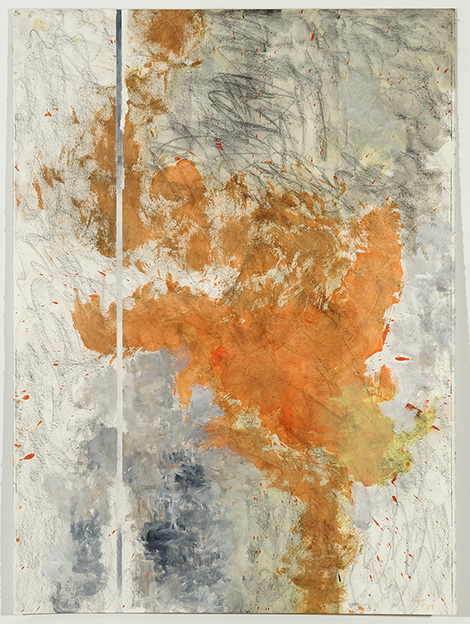Kianja Strobert makes abstract painting the old-fashioned way, with surfaces to die for. Her powdery blacks recall the days when artists ground their own colors—and her gold when nothing else would do. Pigment presses to the edge and then some, as an extension of her own hand. One can see her traces in lighter compositions, like finger-painting, with signs of a tabletop or horizon line. One can see them, too, in the thickest and brightest colors, often red, their irregular outlines like an impulsive afterthought. They allow her, as one title puts it, her Archaism and Ecstasy (2014).
Her surfaces also imply a certain impulsiveness in how they get started. What look like oils on canvas are works on paper, and the ground black is powdered graphite. Strobert might have started with working sketches in pencil and refused to let go. That refusal has led to a density of materials, practically none of them amenable to a brush. They include ink, graphite, acrylic, oil stick and enamel, but also sand, dirt, pumice, beeswax and bone. If they have anything in common, it is an appeal to the sense of touch.
Her two-dozen works the size of modest canvas at the Studio Museum in Harlem date entirely from 2010 on. The oldest are relatively flat and bright. Some then thicken, with more powder and impasto, while others thin out, exposing paper according to the movement of her hand. The most recent add glitter as well as the occasional title. Fifty-one smaller sheets on brown paper look more obviously like drawings: their descending strokes rarely stick to straight lines.
Some recent work also adds imagery or words. The imagery hints at people, and ampersands leave things open-ended. Even when Strobert paints on newsprint, the result looks resolutely abstract. The text, too, appears to refer to the artistic process and emotions, as with asplinter (2014).
Is there a distinctly black abstraction? Not necessarily, although such artists as Melvin Edward have no trouble using formalism to assert their African American identity. For Strobert, though, the question seems hardly even an issue. She appeared in a show of conceptual art in Harlem with a wine stain, as well as among emerging artists at the Studio Museum and in the 2012 art fairs, but her primary reference point is still action painting. Chicken bones could refer to dietary practices, but mostly they just look bare and exposed, much as the powdery graphite can look like ashes.
For all the repeated verticals and imagery, Strobert’s strength lies in neither formalism nor imaginative leaps between abstraction and dreams. Pigment matters more than compositions, and the transformations are still first and foremost of materials. They supply the discoveries, and they make one aware of someone behind their presence on paper, but are they enough? Her surprises may turn out to be part of a longer search for an artistic identity. Four years of surfaces may be only a start.


